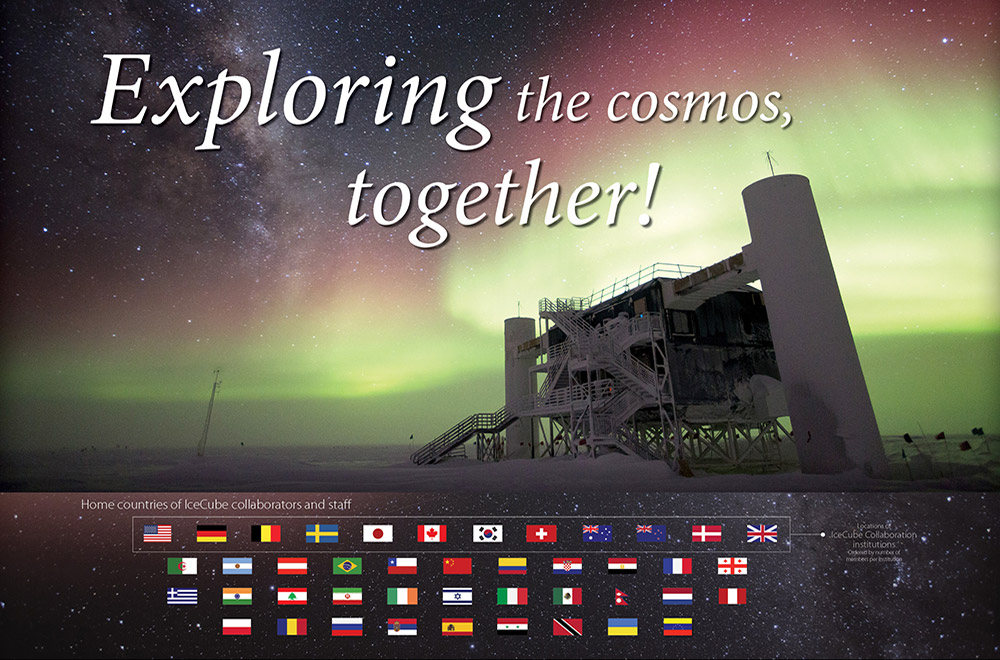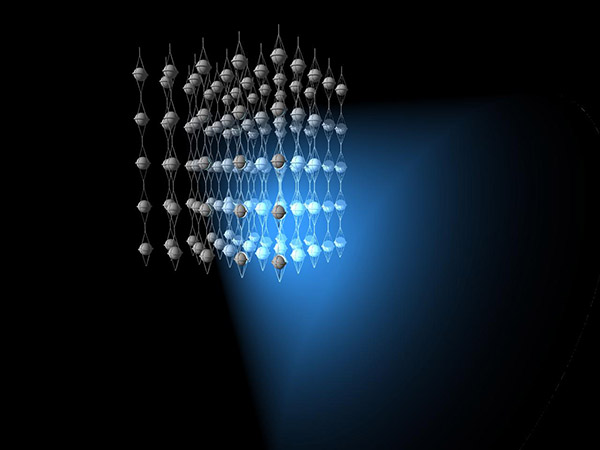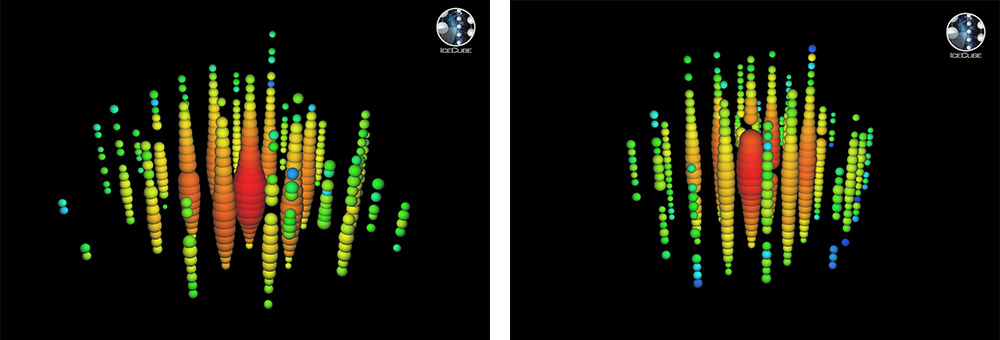ICEHAP’s Neutrino Astronomy Division is a member of the IceCube collaboration conducting neutrino observations.
IceCube is an international collaboration that observes high-energy cosmic neutrinos using 5,160 spherical optical detectors with diameters of 33 cm, buried between 1,500 and 2,500 meters under the ice sheet at the South Pole.
Our team from Chiba University is the only Japanese institution participating in the project. We have been involved in the project since the IceCube collaboration was launched in 2002, and played an important role in researching the most famous neutrino events and in identifying neutrino sources.

The neutrinos the IceCube is looking for are highly transparent elementary particles, and they are extremely difficult to detect because they rarely interact with other matter. However, on the rare occasion they do collide with an atomic nucleus or electron, charged particles are generated and they emit a form of light called Cherenkov radiation. IceCube detects the presence of neutrinos by detecting that Cherenkov radiation.
To learn more about how to capture a neutrino, click here.

In order to increase the frequency at which we can detect neutrino induced events, we need to build a detection facility that encompasses a vast amount of some sort of material - the more matter we can look at the same time, the more neutrino events we can observe. One option is to build a water tank like that installed at the Super-Kamiokande neutrino observatory, where University of Tokyo professors and Nobel Prize winners Masatoshi Koshiba and Takaaki Kajita conducted their experiments. However, the aim of IceCube was to be able to detect events within an even greater volume, so to build a large-enough artificial water tank would require an immense piece of land and an enormous amount of money. It was there that University of Wisconsin-Madison professor Francis Halzen came up with the idea of using the extensive ice sheets at the South Pole. Experiments have been conducted in oceans and lakes, but wind and waves tend to cause issues. There are no such problems in the hard ice of the South Pole, and the highly-transparent ice sheet is said to offer ideal observing environment.
IceCube was developed by an international team led by the University of Wisconsin-Madison, and the enormous observatory was built at Amundsen-Scott South Pole Station, a US research station in Antarctica. IceCube’s predecessor AMANDA (the Antarctic Muon And Neutrino Detector Array) launched in 1996, and construction on the IceCube observatory began in 2004. The observatory was partially running by 2005, and full-scale observations began after its completion in 2011.

The IceCube Neutrino Observatory is constructed at the US Amundsen-Scott South Pole Station in Antarctica. It is located in the center of the continent near the South Pole.
The station was named after Norwegian explorer Roald Amundsen and British explorer Robert F. Scott, both of whom led teams that competed against each other to be the first to reach the South Pole.
Antarctic winters last from March to September, with summers being from around November to February. The average temperature in Antarctica in March can be as low as -45℃.
The IceCube Neutrino Observatory is operated from the IceCube Laboratory (ICL), which is built in the middle of a 1 km diameter area where 86 strings loaded with 5,160 optical detectors were lowered deep into the ice.
The detectors now distributed at depths between 1,450 m and 2,450 m under the surface, making the entire height of the observatory similar to that of the Sixth Station on the slopes of Mt. Fuji.

©IceCube Collaboration
The photodetectors are known as the Digital Optical Modules (DOMs), and there are 60 of them on each string, spaced out at intervals of 17 m. All the detectors are connected to the ICL by the cables, which they use to draw power and send detection data.

© Erik Beiser, IceCube/NSF
The ICL is built at the center of the area of ice the observatory array was embedded in, and it stands on stilts in order to prevent the laboratory from being buried in deep snow. It was originally a residence for researchers working in Antarctica in the summer but was renovated for use in the IceCube observatory. The tall pillar-like structures to the left and right of the ICL house the cables that connect to the 5,160 detectors in the ice below.

The optical detectors at IceCube are called the Digital Optical Modules, or DOMs, and they capture emissions of Cherenkov radiation in the ice. Spherical in shape, each is around 30 cm in diameter and holds within it a photomultiplier tube (PMT) that is pointed downwards. The PMTs detect weak, instantaneous emissions of Cherenkov radiation and amplify the signal. That signal is then sent to the DOM’s mainboard for quick processing.
Learn more about the DOMs here.
This timeline provides a glimpse into the history of IceCube, from when the idea of building a neutrino observatory in the South Pole ice sheet was first proposed, up to the current day.



















It took more than five years to complete construction on the IceCube Neutrino Observatory. Finally, it was finished in December 2010. The following year, full-scale operations began using all optical sensors, and since then researchers have detected numerous high-energy neutrinos, and succeeded in producing a variety of other results as well.
Construction on the IceCube Neutrino Observatory was completed in December 2010 after more than five long years of work. In April of 2011, the observatory began operating using the entire IC-86 array, which included all 5,160 DOMs interconnected on 86 strings.
The Chiba University team analyzed observational data gathered by the now completed IceCube and discovered that the observatory had captured two events that seemed to be Cherenkov radiation emitted by neutrinos interacting with the ice, with one neutrino at an energy of 1.2 PeV (petaelectronvolts, or 1015 electronvolts) and one at 1.4 PeV.
The first event was detected in August 2011, soon after the entire array began operating. At 1.04±0.16 PeV, that high-energy cosmic neutrino set off a flood of 10,000 photons that flew into the detectors.
The second event occurred in January 2012, and that time the team confirmed that the neutrino had an equally enormous energy of 1.14±0.17 PeV. These two events were later named Bert and Ernie after the characters on the long-running American children’s show Sesame Street. Both resulted in beautiful images of ice-like showers that seemed almost like computer-generated graphics, each large signal exploding at the heart of the IC-86 detector array.

After observing these two events, the researchers followed up by searching for other neutrinos in the same low-energy region (3x1013 electronvolts or 30 TeV), and they found 26 more events to add to the two discovered previously. The expected number of background events among these 28 events is 11, but considering the observed energies, event topologies, and incident angles, it is thought unlikely that all of the other 26 events can be explained away as background events. When combined with the first two events observed, the analysis proved with a statistical significance greater than 4σ that these were not atmospheric neutrinos but the world’s first observation of high-energy cosmic neutrinos. These were the first neutrinos from outside our solar system captured since Kamiokande captured its signals in 1987, and the discovery expanded the observational realm of neutrino astronomy to high-energy regions 100 million times greater than before.
The Chiba University team presented this research at an international conference in June 2012 as the first observation to show the existence of theoretically predicted high-energy cosmic neutrinos. The team then compiled the results of their analysis of these special, extremely high energy or EHE neutrinos and had a letter paper published in the science journal Physical Review Letters in July 2013. The IceCube group then published another paper summarizing additional analyses inScience in December 2013. These analyses were lauded as unshakeable evidence of the existence of cosmic neutrinos, and the result was named “Breakthrough of the Year” by the British journal Physics World. The observations served as the world’s first evidence hinting at the existence of “cosmic engines” that accelerate particles and emit neutrinos and made it possible to estimate the number of high-energy neutrinos that can be found throughout the universe.

Journal:Physical Review Letters
Title of Paper:
First observation of PeV-energy neutrinos with IceCube
Author(s):IceCube Collaboration
DOI: 10.1103/PhysRevLett.111.021103
Journal:Science
Title of Paper:Evidence for High-Energy Extraterrestrial Neutrinos at the IceCube Detector
Author(s):IceCube Collaboration
DOI: 10.1126/science.1242856
After the first detections made in 2012, IceCube detected many more high-energy cosmic neutrinos, but no source for those neutrinos was found.
That was until 2017, when using the track angle of IC170922A - a neutrino event detected by IceCube - observatories around the world worked together to track the path back to its source, marking this as the first successful identification of a neutrino generating body.

The two papers below describing the research conducted were published in the US journal Science. The result attracted attention both in Japan and overseas and was selected as one of the top ten breakthroughs of the year by Science.
Journal:Science
Title of Paper:Multimessenger observations of a flaring blazar coincident with high-energy neutrino IceCube-170922A
Author(s):The IceCube, Fermi-LAT, MAGIC, Kanata, Kiso teams et al.
DOI:10.1126/science.aat1378
Journal:Science
Title of Paper:Neutrino emission from the direction of the blazar TXS 0506+056 prior to the IceCube-170922A alert
Author(s):IceCube Collaboration
DOI:10.1126/science.aat2890
Learn more about multi-messenger astronomy here.

©ICEHAP/IceCube Collaboration
The IceCube Collaboration is made up of research institutions from around the world. As of 2020, there are 53 different institutions from 12 countries taking part. The approximately 300 researchers working on IceCube are known as IceCubers. They work at different institutions and in different countries but interact regularly through online meetings.
IceCube Collaboration Meetings are held twice a year, and they provide the researchers with a valuable opportunity to gather in one place and report on the progress of their own work and exchange other information. The group photograph here was taken during the Collaboration Meeting held at Chiba University in 2019. With the global spread of COVID-19, the meetings are now being held online, but everyone is looking forward to a time when they can meet again in real life.
Two plans are currently in place for the future of IceCube.
Construction on IceCube Upgrade is scheduled to begin in 2022, and the next generation of the observatory, known as Gen-2, will begin after.
IceCube Upgrade will see the installation of 700 new high-performance photodetection devices in the ice. Gen2 will have an observational volume around eight times larger than the current IceCube, and point source sensitivity more than five times higher.
Since the identification of the source of the 2017 neutrino event, one of our major goals for the future is to strengthen our collaborations with other observatories engaged in multi-messenger astronomy and identify more neutrino sources. In order to achieve this, we need to detect more neutrinos, which give us a path to trace back, and increase the number of observations made. IceCube will continue to evolve in pursuit of this goal, with the aim of identifying more sources of neutrinos.

©IceCube Collaboration
Learn more about IceCube Upgrade and IceCube-Gen2 here.